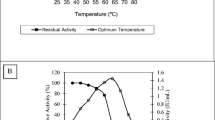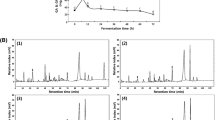Abstract
The objective of this study was to follow the metabolic fate of isoflavone glucosides from the soybean meal in a model industrial fermentation to determine if commercially useful isoflavones could be harvested as coproducts from the spent broth at the end of the fermentation. The isoflavone aglycones, genistein, and daidzein together make up 0.1–0.2 % of the soybean meal by weight but serve no known function in the manufacturing process. After feeding genistein to washed cells of the erythromycin-producing organism, Saccharopolyspora erythraea, the first biotransformation product (Gbp1) was determined by X-ray crystallography to be genistein-7-O-α-rhamnoside (rhamnosylgenistein). Subsequent feeding of rhamnosylgenistein to growing cells of Saccharopolyspora erythraea led to the production of a second biotransformation product, Gbp2. Chromatographic evidence suggested that Gbp2 accumulated in the spent broth of the erythromycin fermentation. When the spent broth was hydrolyzed with acid or industrial enzyme preparations, the isoflavone biotransformation products were returned back to their parental forms, genistein and daidzein, which were then recovered as coproducts. Desirable features of this method are that it does not require modification of the erythromycin manufacturing process or genetic engineering of the producing organism to be put into practice. A preliminary investigation of five additional antibiotic fermentations of industrial importance also found isoflavone coproduct potential.






Similar content being viewed by others
References
Bérdy J (2005) Bioactive microbial metabolites, a personal view. J Antibiot 58:1–26
Chimura H, Sawa T, Kumada Y, Naganawa H, Matsuzaki M, Takita T, Hamada M, Takeuchi T, Umezawa H (1975) New isoflavones, inhibiting catechol-O-methyltransferase, produced by Streptomyces. J Antibiot 28:619–626
Cortes J, Velasco J, Foster G, Blackaby AP, Rudd BA, Wilkinson B (2002) Identification and cloning of a type III polyketide synthase required for diffusible pigment biosynthesis in Saccharopolyspora erythraea. Mol Microbiol 44:1213–1224
Dijsselbloem N, Vanden Berghe W, De Naeyer A, Haegeman G (2004) Soy isoflavone phyto-pharmaceuticals in interleukin-6 affections. Multi-purpose nutraceuticals at the crossroad of hormone replacement, anti-cancer and anti-inflammatory therapy. Biochem Pharmacol 68:1171–1185
Fidler DJ, George B, Quarles CL, Kidd MT (2003a) Broiler performance and carcass traits as affected by dietary liquid Saccharopolyspora solubles concentrate. J Appl Poult Res 12:153–159
Fidler DJ, Lampel JS, Weyant DB (September 2003b) Concentrated spent fermentation beer or Saccharopolyspora erythraea activated by an enzyme mixture as a nutritional feed supplement. U.S. patent 6,616,953
Hessler PE, Larsen PE, Constantinou AI, Schram KH, Weber JM (1997) Isolation of isoflavones from soy-based fermentations of the erythromycin-producing bacterium Saccharopolyspora erythraea. Appl Microbiol Biotechnol 47:398–404
Hosny M, Rosazza J (1999) Microbial hydroxylation and methylation of genistein by streptomycetes. J Nat Prod 62:1609–1612
Kidd MT, Fidler DJ, Koch KB, George B, Quarles CL (2003) Dietary addition of liquid Saccharopolyspora solubles concentrate positively affects pellet mill throughput and broiler performance. J Appl Poult Res 12:145–152
Komiyama K, Funayama S, Anraku Y, Mita A, Takahashi Y, Omura S, Shimasaki H (1989) Isolation of isoflavonoids possessing antioxidant activity from the fermentation broth of Streptomyces sp. J Antibiot 42:1344–1349
Maatooq GT, Rosazza JP (2005) Metabolism of daidzein by Nocaradia species NRRL 5646 and Mortierella isabellina ATCC 38063. Phytochemistry 66:1007–1011
Minas W (2005) Production of erythromycin with Saccharopolyspora erythraea. In: Barredo JL (ed) Methods in biotechnology, Vol. 18: microbial processes and products. Humana, Totowa, pp 65–89
Murphy PA, Hendrich S (2002) Phytoestrogens in foods. Adv Food Nutr Res 44:195–246
Queener SW, Lively DH (1986) In: Demain AL, Soloman NA (eds) Manual of industrial microbiology and biotechnology. American Society for Microbiology, Washington DC, pp 155–169
Quirós LM, Aguirrezabalaga I, Olano C, Méndez C, Salas JA (1998) Two glycosyltransferases and a glycosidase are involved in oleandomycin modification during its biosynthesis by Streptomyces antibioticus. Mol Microbiol 28:1177–1185
Reeves AR, Cernota WH, Brikun IA, Wesley RK, Weber JM (2004) Engineering precursor flow for increased erythromycin production in Aeromicrobium erythreum. Metab Eng 6:300–312
Reeves AR, Brikun IA, Cernota WH, Leach BI, Gonzalez MC, Weber JM (2006) Effects of methylmalonyl-CoA mutase gene knockouts on erythromycin production in carbohydrate-based and oil-based fermentations of Saccharopolyspora erythraea. J Ind Microbiol Biotechnol 33:600–609
Reeves AR, Weber JM, Brikun IA (2007) Methods of increasing production of secondary metabolites by manipulating metabolic pathways that include methylmalonyl-CoA. U S Pat Appl 20070122885
Reeves AR, Seshadri R, Brikun IA, Cernota WH, Gonzalez MC, Weber JM (2008) Knockout of the erythromycin biosynthetic cluster gene, eryBI, blocks isoflavone glucoside bioconversion during erythromycin fermentations in Aeromicrobium erythreum but not in Saccharopolyspora erythraea. Appl Environ Microbiol 74:7383–7390
Seo J, Kang S, Kim M, Han J, Hur H-G (2011) Flavonoids biotransformation by bacterial non-heme dioxygenases, biphenyl and naphthalene dioxygenase. Appl Microbiol Biotechnol 91:219–228
Sheldrick GM (2008a) SADABS; Department of Structural Chemistry. University of Göttingen, Göttingen, Germany
Sheldrick GM (2008b) Acta Crystallogr Sect A: Found Crystallogr 64:112–122
Swanson M, Stoll M, Schapaugh W, Takemoto L (2004) Isoflavone content of Kansas soybeans. Am J Undergr Res 2:27–32
Virk-Baker MK, Nagy TR, Barnes S (2010) Role of phytoestrogens in cancer therapy. Planta Med 76:1132–1142, Epub 2010 Jul 1
Acknowledgments
We acknowledge the Small Business Innovation Research program and the National Institutes of Health for grants R43 CA93165 and R44 CA93165 from the National Center for Complementary and Alternative Medicine. We acknowledge Igor Brikun, Andrey Fedashtchin, Noelle Kwan, Ben Leach, Cheryl Iverson, and John Aikens for the helpful discussions.
Author information
Authors and Affiliations
Corresponding author
Electronic supplementary material
Below is the link to the electronic supplementary material.
ESM 1
(DOC 76 kb)
Rights and permissions
About this article
Cite this article
Weber, J.M., Reeves, A.R., Seshadri, R. et al. Biotransformation and recovery of the isoflavones genistein and daidzein from industrial antibiotic fermentations. Appl Microbiol Biotechnol 97, 6427–6437 (2013). https://doi.org/10.1007/s00253-013-4839-4
Received:
Revised:
Accepted:
Published:
Issue Date:
DOI: https://doi.org/10.1007/s00253-013-4839-4




